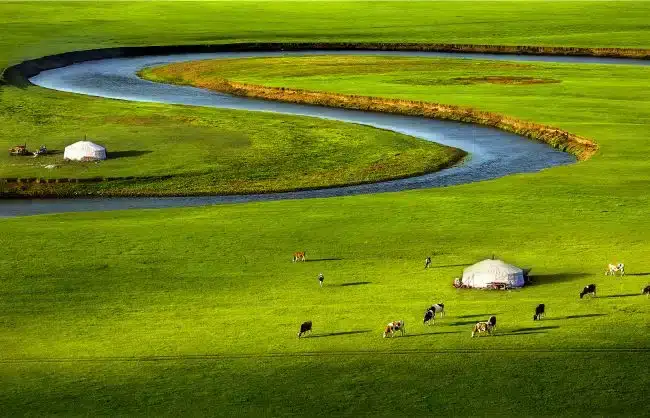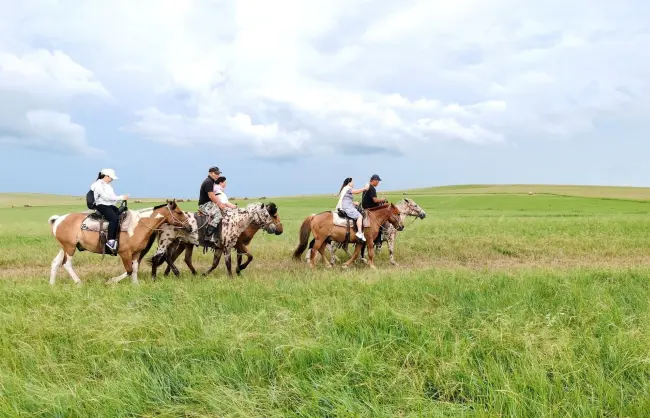Hulunbuir Grassland in the northeast of Inner Mongolia, is one of the four largest grasslands in the world and the largest in China. It is known as “the Grass Kingdom” because of its rich biodiversity. Hulunbuir Grassland is also the best-preserved grassland in China, so it is called “the Purest Prairie” as well. Its many titles should tell you how well-regarded and impressive it is.
If you’ve never visited a grassland before, you should definitely travel to Hulunbuir in Inner Mongolia. Hulunbuir Grassland is your top choice for seeing the boundless prairie, experiencing nomadic lifestyle, and learning about local culture and Genghis Khan history.
Fast Facts about Hulunbuir Grassland
- Location: Hulunbuir city, Inner Mongolia, China
- Hours: all day
- Ticket price: the grassland is free for visit, but some activities may cost a fee
- Recommended visit time: 2 or 3 days
- Best time of the year: June to August
- Suited to: nature lovers, photographers, anyone wishes to experience Inner Mongolia culture
Why Visit Hulunbuir Grassland?
- Huge stretches and a charming setting: One of the four largest grasslads in the world, and the most exquisite and pristine grassland in China. Roughly equal to 16 times of Beijing’s size.
- Rich rivers and lakes: Home to over 3,000 meandering rivers and rich lakes, including the famous Hulun Lake, Buir Lake, and Morigele River.
- Mongolian cultural experience: Formerly the birthplace of northern nomadic tribes. Provides genuine hunting and nomadic customs. Here you can live like a herder for a day, and experience authentic Mongolian culture.

Overview of Hulunbuir Grassland
So how big exactly is Hulunbuir Grassland? It has an area of over 43,500 square miles (11,266,700 hectares), that is six times as large as Beijing! The area consists 80% of natural grassland and over 3,000 rivers and 500 lakes.
Hulunbuir is named after two lakes in this region, Hulun Lake and Buir Lake. Both “Hulun” and “Buir” refer to otters in Mongolian, because the two lakes are home to a large population of otters. Other than that, there also a beautiful legend behind the name of Hulunbuir.
Legend goes that there was once a Mongolian tribe living in peace on the grassland. In it, there’s a couple, Hulun and Buir. The girl, Hulun, is beautiful, has a talent for singing and dancing. And Buir is an excellent solider, incredibly strong and skilled in riding on horseback and archery.
One day, a demon showed up and destroyed the beautiful grassland, all the plants and animals, rivers and lakes. To save their tribe, the couple stood bravely against the demon. Hulun transformed into a lake to drown the demon and his army. When Buir came and couldn’t find her anywhere by the lake, he dove in. All of a sudden, the earth started shaking. Another lake was formed.
What to See and Do on Hulunbuir Grassland
1. Vast Natural Grassland
Take in the beautiful scenery of the boundless Hulunbuir Grassland. Imagine yourself under a clear blue sky, on the fresh green grass, amongst summer wildflowers. You’ll see cattle and sheep wondering wandering about. It is truly a paradise on earth. If you’re in the mood for some grassland activities, you can take a horseback ride or try the exciting grass slides.
2. Lake Hulun and Buir
Hulun Lake is the largest lake in Inner Mongolia and one of the largest freshwater lakes in China. Most of Buir Lake is located in Mongolia. The lakes are a perfect spot for boating and fishing. The surrounding area is also great for a family picnic and a quiet walk by yourself or with your loved ones.
Hulun lake is not very far from Manzhouli, where Mongolia, China and Russia meet. So it’s a good idea to visit Manzhouli while you’re there to see how three different cultures come together in one place.

3. Heishantou
Heishantou is a quiet small town at the foot of a mountain on the grassland. It is known for its gorgeous sunset and night sky. Around dusk, you can hike or ride a horse up the hill to see the orange sun set on the horizon where Russia and China meet.
4. Unique Mongolian Culture
A Hulunbuir Grassland tour is not complete without experiencing the nomadic lifestyle. Spend a night or two in a Mongolian yurt. These traditional accommodations have everything you need. Simply step out of your room, you’ll see the endless grassland and the clear night sky around you. Plus, you get to join the fun bonfire parties at night with the locals.
While you’re at Hulunbuir Grassland, make sure you try local delicacies such as roasted lambs, Mongolian barbeque, milk tea, cheese, and shaomai. Because the environment here is so well-preserved, produce like meat, milk, leather, wool are of excellent quality.
The most exciting time to visit Hulunbuir Grassland is definitely during the Naadam Festival. You’ll see the famous “three games of men,” horse racing, wrestling, archery, as well as traditional singing and dancing. It is the biggest event every year in Mongolian culture.
5. Morigele River (莫尔格勒河)
Twisting and turning like a jade dragon across the grasslands, the Morigele River meaders over 300 kilometers from the Greater Khingan Mountains to Hulun Lake and the Hailar River. Though its length, it is not particularly wide, stretching a mere five to six meters at its broadest. Its winding path forms epic meanderings, which is the top highlight of the river.
The river is flanked by adorable yurts, fluffy sheep and cattle herds, and lush pastures, creating a perfect pastoral scene.
6. Enjoy a Bonfire Party At Night
Don’t miss a bonfire party at night when you are traveling to Hulunbuir. As an essential part of the grassland experience, the joy of the bonfire party will leave you with an unforgettable memory. As night falls, people will get together at the gathering point. When there are enough participants, the bonfire will be lit. Then, you can join locals to sing, dance, savor freshly roasted meat, enjoy drinks, and immerse yourself in the spirit of relaxation and celebration.
Bonfire parties are available at most popular grassland tourist spots, such as the Golden Mongolian Tribe, Hongjila Tribe, and Barhu Mongolian Tribe.
Best Time to Visit Hulunbuir Grassland
The best time for your Inner Mongolia tour to Hulunbuir Grassland is during the summer months, from June to August. The weather is warm with sunny clear days. The grass is green dotted with wildflowers. The temperature usually ranges from 59°F to 77°F (15°C to 25°C). It’s the perfect season for outdoor activities like horseback riding.
Autumn (September to October) is also a good time to visit for a different, golden landscape and cooler temperatures. But keep in mind that the temperature difference between day and night can be significant. So be sure to pack something warm.
Another thing you might want to consider is Nadam Festival. It takes place twice a year on Hulunbuir Grassland, with the Summer Naadam in late July and Winter Naadam in late December.

How to Get to Hulunbuir Grassland
By Air: Hailar Dongshan International Airport is the nearest airport to Hulunbuir Grassland. There are regular flights from cities like Beijing, Shanghai, Harbin. The airport is about a 2.5-hour drive from the grassland.
By Train: You can also take a train and see the countryside along the way, but it can be very time-consuming. There is no high-speed train station nearby. A train from Beijing can take more than 30 hours.
By Car: When you’re in Hailar, you can get to Hulunbuir Grassland by car or bus. Renting a car or hiring a private driver is the easiest way. You can also book for a local guided tour.
Attractions nearby Hulunbuir Grassland
- Manzhouli Matryoshka Squarein Manzhouli, Hulunbuir, is a large attraction with giant matryoshka dolls. Because of its location near the border of China and Russia, you’ll find a fusion of Chinese, Russian, and Mongolian culture at this popular attraction.
- Sino-Russian border Highwayis along the border control line between China and Russia. The view is absolutely stunning driving down this highway. You’ll see endless grasslands, winding rivers, and rolling hills on your sides.
- White Birch Forest Scenic Areais a picturesque forest park that has a massive area of white birch trees, grasslands, lakes, and wooden houses.









